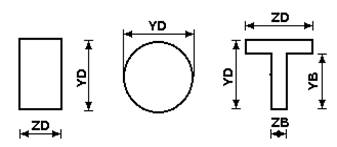D13.D.1 General
Analysis according to the first group of limit states is performed to avoid the following phenomena:
-
brittle, plastic or other type of failure,
-
loss by structure of stable form or position,
Analysis according to the second group of limit states is performed to avoid the following phenomena:
-
excessive opening of cracks (if they are allowed according to service conditions)
Analysis of structures for the first group of limit states is performed for the maximum (design) loads and actions. Analysis of structures for the second group of limit states is made in accordance with the operational (normative) loads and actions. Ratio between design and normative loads is called reliability coefficient for loads which is determined according to SNiP 2.01.07.-85 Loads and actions.
STAAD.Pro calculates reinforcement for concrete members. Algorithms for calculation of reinforcement of concrete linear (beams, columns) and 2D (two dimensional) (slabs, walls, shells) members are incorporated into STAAD.Pro. In addition to SP5 2.13330.2011, the Guide for design of plain concrete and reinforced concrete structures from normal weight and lightweight concrete (to SNiP 2.03.01-84) has been incorporated in the calculation algorithms.
STAAD.Pro calculates reinforcement for beams of rectangular or T section and for columns of rectangular or circular section (Fig.1).

Notation of dimensions for rectangular, circular and T sections
The flange of T-shape beams may be situated at the top zone of the section if the angle BETA=0°, or at the bottom zone of the section, if BETA=180°.
